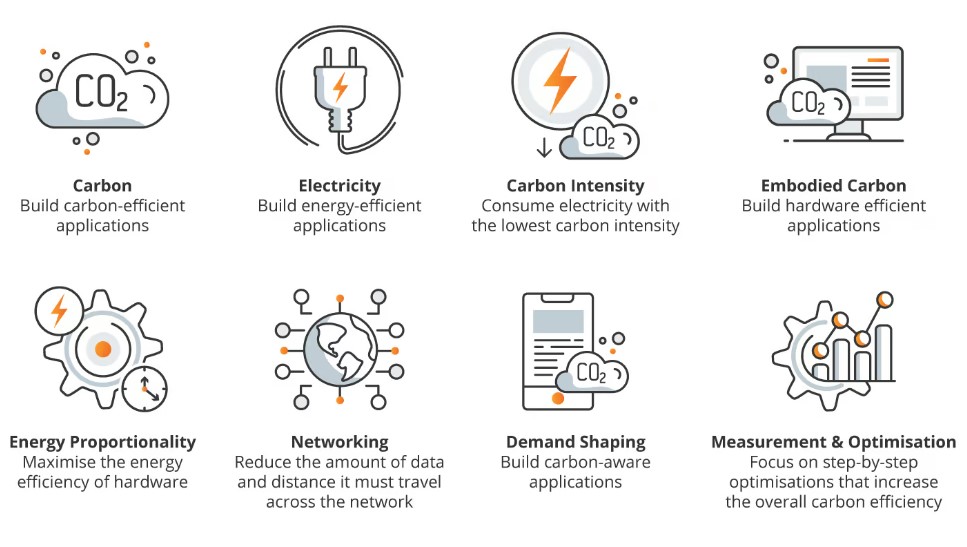
As the world grapples with the escalating impacts of climate change, the tech industry faces a critical challenge: how to develop software in a way that minimizes environmental harm. Enter green coding, a transformative approach that prioritizes sustainability in software engineering.
This article explores the principles of green coding, highlighting its significance in fostering eco-friendly practices and reducing energy consumption. We will delve into the multifaceted strategies that businesses can adopt to implement sustainable software development, ultimately contributing to a healthier planet. By understanding the importance of green software engineering, organizations can not only enhance their operational efficiency but also play a vital role in combating climate change.
What is Green Coding?
Green coding involves creating software in a manner that reduces energy usage and minimizes environmental harm. Moreover, it embodies a sustainable approach that aids organizations in lowering greenhouse gas emissions, thereby contributing to the fight against climate change and promoting sustainability efforts.
Furthermore, as a part of green computing—which is a broader concept in the tech field—green coding focuses on decreasing carbon emissions across multiple facets of software operations. Specifically, this includes optimizing data centers, improving daily team workflows, and enhancing software development processes. Ultimately, companies dedicated to green coding utilize eco-conscious software solutions to adopt energy-efficient and environmentally responsible practices.

Why is it important for Software Developers to practice Green Coding?
When most individuals hear the term ‘sustainability,’ they often associate it with recycling and maintaining clean environments. However, in the realm of technology, sustainability encompasses a more profound and frequently neglected aspect. As digital consumption continues to rise, the demand for servers and data centers is also escalating. Consequently, we are witnessing a rapid increase in the amount of data generated and the energy needed to support this data.
In fact, experts estimate that by 2025, the information and communications technology sector could account for nearly 20% of the world’s electricity consumption and contribute up to 5.5% of all carbon emissions. To address this pressing issue, green coding emerges as an ideal solution for managing and reducing energy use and carbon emissions associated with software products.
This innovative concept promotes the adoption of eco-friendly coding practices. By implementing these green coding strategies, software companies can create healthier environments and conserve valuable resources effectively.
The 8 principles of Green Software Engineering
Green software engineering principles provide a framework for adopting eco-friendly coding practices. This includes the development, design, and implementation of sustainable software solutions.
Green software engineering is divided into eight distinct areas:
Carbon: Develop software applications that prioritize carbon efficiency
The Carbon principle emphasizes the importance of minimizing carbon emissions in the creation of digital products. As carbon emissions are an inevitable by-product of various activities, software developers can enhance their code to consume less energy, choose energy-efficient hardware, and implement various energy-saving strategies.
Electricity: Create software applications that are efficient in their electricity usage
The Electricity principle focuses on lowering the electricity consumption of software systems. This can be accomplished by designing digital systems that require less energy, ensuring that software operates on low power, and adopting power management techniques to further decrease energy use.
Carbon Intensity: Use electricity with the least carbon intensity
Utilizing electricity from renewable sources such as hydropower, solar, and wind energy can help lower carbon intensity, which is defined as the amount of carbon emissions generated per kilowatt-hour.
Embodied Carbon: Develop applications that are efficient in terms of hardware use
Embodied carbon refers to the carbon emissions associated with the creation, use, and disposal of a device. This principle advocates for the use of recycled materials, minimizing waste, and creating hardware-efficient applications. Companies should consider the environmental impact of each digital product throughout the software development lifecycle.
Energy Proportionality: Enhance the energy efficiency of hardware
Energy proportionality assesses the energy consumed by a computer system compared to the useful output it generates. An optimized system is one that is energy-efficient; for instance, an idle computer has low utilization, while a device running at full capacity is highly utilized. It is essential to prioritize hardware that provides the best performance with the least energy consumption. For example, adopting cloud computing as part of green computing can streamline operations and reduce the need for physical servers.
Networking: Minimize data volume and the distance it travels across the network
Networking efficiency involves optimizing data transfers and cutting down on data redundancy. By streamlining data pathways and eliminating unnecessary data transmissions, energy consumption and associated costs can be reduced. For instance, cloud-based DevOps can lower the amount of data that needs to be transferred across the network, thereby decreasing overall network energy usage.
Demand Shaping: Create carbon-aware applications
Applications should be designed with their carbon footprint in mind. Demand shaping refers to the management of energy consumption to coincide with periods of low-carbon electricity availability. This means distributing workloads in a way that balances energy use, which can be achieved through load balancing, resource scheduling, and workload management.
Optimization: Emphasize gradual improvements that boost overall carbon efficiency
The journey to sustainable software development should be viewed as a marathon rather than a sprint. In fact, this long-term approach will benefit software companies and the industry as a whole. Moreover, implementing a consistent strategy to ensure carbon efficiency across the tech stack, user experience, data center design, and other areas will lead to significant outcomes and align with sustainability goals.
To implement these sustainability practices, start with a decarbonization plan within your software development process and identify areas for optimization in your application design. Instead of making sweeping changes, it is advisable to focus on incremental improvements. Ultimately, each small step contributes to creating a more carbon-efficient application over time. Consequently, this gradual approach not only fosters innovation but also enhances overall sustainability efforts.

Benefits of Green Coding in Software Engineering
Climate change affects everyone and poses significant threats to our environment. However, implementing green coding practices within your development team offers numerous advantages. You can play a vital role in creating sustainable solutions by actively supporting your team and addressing their pressing questions.
Here are some key benefits of adopting green coding:
1. Energy Efficiency
Adopting green coding practices in software engineering can significantly reduce energy consumption. By selecting energy-efficient coding methods, leveraging cloud computing, and optimizing IT infrastructure, businesses can effectively lower both their energy use and carbon footprint.
2. Enhanced Sustainability Goals
Many organizations are striving to achieve net-zero emissions. For instance, sustainability is a core value at Google, which aims for net-zero emissions across its entire value chain. By practicing green coding, companies can accelerate their progress toward these sustainability objectives.
3. Increased Revenue Opportunities
Incorporating green coding in software development leads to reduced energy consumption, which translates to lower costs. Consequently, companies can report higher operational margins compared to their industry peers, thanks to decreased energy expenses.
4. Faster and Improved Iterative Development
Green coding streamlines the coding process, allowing developers to write less code and simplify the hardware infrastructure within organizations. As a result, developers can focus on producing higher-quality digital products.
5. Attracting and Retaining Top Tech Talent
As the tech industry increasingly embraces sustainable practices, companies that prioritize green coding will attract talent that shares their values. Professionals are eager to align themselves with organizations committed to fostering a better environment.
6. Brand Loyalty
Demonstrating a commitment to environmental issues can attract millennials and other generational cohorts to a brand. For example, Unilever is focused on eliminating fossil fuels and transitioning to renewable energy. Similarly, Apple has recently launched its first carbon-neutral product and is actively working to decarbonize its product lifecycle. By understanding the importance of combating climate change and promoting a healthy environment, businesses can enhance brand loyalty and retention.
7. Long Lifespan
Developing software applications with sustainability in mind promotes longevity. This strategy minimizes the need for frequent updates and replacements, thereby reducing waste over time.
8. Regulatory Compliance
Green software engineering aligns with government regulations and environmental standards. By adopting green coding practices, companies can avoid penalties and legal issues while ensuring compliance. Integrating these practices into the software development process guarantees that organizations remain compliant and energy-efficient.
Conclusion
Green coding practices play a crucial role in maintaining a healthy environment. By writing code and creating decarbonized digital products, you can promote eco-friendly practices within your organization. When you implement green software engineering, your business stands to gain from lower IT hosting costs and reduced expenses for cloud services.
While gradually integrating these practices may take time and involve necessary changes, the long-term benefits are well worth the effort. This transition will require both structural and cultural shifts within your organization.
For example, you will need to focus on establishing IT-efficient infrastructures and adopting cloud-based DevOps. To successfully navigate this process, it is essential to have a top-tier software development team in place. Therefore, consider augmenting your team with skilled software developers who are well-versed in green coding practices.


